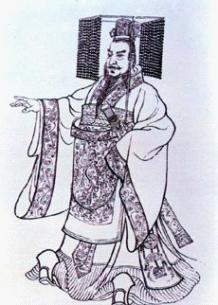[hdu P4081] Qin Shi Huang’s National Road System
Posted
tags:
篇首语:本文由小常识网(cha138.com)小编为大家整理,主要介绍了[hdu P4081] Qin Shi Huang’s National Road System相关的知识,希望对你有一定的参考价值。
[hdu P4081] Qin Shi Huang’s National Road System
Time Limit: 2000/1000 MS (Java/Others) Memory Limit: 32768/32768 K (Java/Others)
Problem DescriptionDuring the Warring States Period of ancient China(476 BC to 221 BC), there were seven kingdoms in China ---- they were Qi, Chu, Yan, Han, Zhao, Wei and Qin. Ying Zheng was the king of the kingdom Qin. Through 9 years of wars, he finally conquered all six other kingdoms and became the first emperor of a unified China in 221 BC. That was Qin dynasty ---- the first imperial dynasty of China(not to be confused with the Qing Dynasty, the last dynasty of China). So Ying Zheng named himself "Qin Shi Huang" because "Shi Huang" means "the first emperor" in Chinese.
Qin Shi Huang undertook gigantic projects, including the first version of the Great Wall of China, the now famous city-sized mausoleum guarded by a life-sized Terracotta Army, and a massive national road system. There is a story about the road system:
There were n cities in China and Qin Shi Huang wanted them all be connected by n-1 roads, in order that he could go to every city from the capital city Xianyang.
Although Qin Shi Huang was a tyrant, he wanted the total length of all roads to be minimum,so that the road system may not cost too many people‘s life. A daoshi (some kind of monk) named Xu Fu told Qin Shi Huang that he could build a road by magic and that magic road would cost no money and no labor. But Xu Fu could only build ONE magic road for Qin Shi Huang. So Qin Shi Huang had to decide where to build the magic road. Qin Shi Huang wanted the total length of all none magic roads to be as small as possible, but Xu Fu wanted the magic road to benefit as many people as possible ---- So Qin Shi Huang decided that the value of A/B (the ratio of A to B) must be the maximum, which A is the total population of the two cites connected by the magic road, and B is the total length of none magic roads.
Would you help Qin Shi Huang?
A city can be considered as a point, and a road can be considered as a line segment connecting two points.InputThe first line contains an integer t meaning that there are t test cases(t <= 10).
For each test case:
The first line is an integer n meaning that there are n cities(2 < n <= 1000).
Then n lines follow. Each line contains three integers X, Y and P ( 0 <= X, Y <= 1000, 0 < P < 100000). (X, Y) is the coordinate of a city and P is the population of that city.
It is guaranteed that each city has a distinct location.OutputFor each test case, print a line indicating the above mentioned maximum ratio A/B. The result should be rounded to 2 digits after decimal point.
Sample Input
2
4
1 1 20
1 2 30
200 2 80
200 1 100
3
1 1 20
1 2 30
2 2 40Sample Output
65.00
70.00
Source
2011 Asia Beijing Regional Contest
一道很不错的题目。
题目大意:
(不想写了,应用一下zk大佬的吧)秦始皇要在n个城市之间修路,他想使得n个城市构成一个树形结构,并使得连接的路的长度和最小。这时,徐福说他有一种办法使得一条路不需要任何花销
就能直接修成。秦始皇想让他修这些必要的路中最长的一条,但是徐福想修造福人口数最多的一条(即该条路连接的两个城市的人口和)。于是秦始皇为了均衡矛盾,给出了一种计算方法,将一条路两端
的人口数A除以其他(n-2)条需要建造的道路的总长B,即计算A/B的比值,选取比值最大的一条修。输出该条路的比值。简而言之,该题就是要求除了徐福变的那条边既可以在秦始皇原定道路上,也可以不
在,其他边都要在秦始皇原定道路上,然后要使徐福变的那条路A/B的值最大。
我们仔细思考,对于每一条路,其A值是固定的,我们要让其B值最小化。
那我们会想到与MST有点关联。那我们先构造出MST,设权值和为sum。
构造出MST后,对于每一条边:
如果在原MST上,则:ans=max(ans,(p[x]+p[y])/(sum-dis(x,y));
如果不在原MST上,怎么办呢?
由于我们要强制将这条边加入生成树,而我们又要维持生成树只有n-1条边的性质,所以我们就要删掉一条边,且这条边满足删去以后保持生成树且边权值最大。
那这就是一个次小生成树的模型了。
关于次小生成树:
code:
 View Code1 #include<bits/stdc++.h> 2 #define sqr(x) ((x)*(x)) 3 #define ms(a,x) memset(a,x,sizeof a) 4 const int N=1005; 5 using namespace std; 6 int n,x[N],y[N],p[N],pre[N]; 7 double f[N],d[N][N],g[N][N],sum,ans; 8 bool vis[N],used[N][N]; 9 inline int read() { 10 int x=0; char ch=getchar(); 11 while (ch<‘0‘||ch>‘9‘) ch=getchar(); 12 while (ch>=‘0‘&&ch<=‘9‘) x=x*10+ch-‘0‘,ch=getchar(); 13 return x; 14 } 15 double dis(int a,int b) { 16 return sqrt(1.0*sqr(x[a]-x[b])+1.0*sqr(y[a]-y[b])); 17 } 18 int main() { 19 for (int T=read(); T; T--) { 20 n=read(),sum=0; 21 for (int i=1; i<=n; i++) 22 x[i]=read(),y[i]=read(),p[i]=read(); 23 for (int i=1; i<=n; i++) 24 for (int j=1; j<=n; j++) d[i][j]=dis(i,j); 25 ms(g,0),ms(pre,0),ms(used,0),ms(vis,0),vis[1]=1; 26 for (int i=1; i<=n; i++) 27 f[i]=g[1][i]=d[1][i],pre[i]=1; 28 for ( ; ; ) { 29 int k=-1; double minor=1e18; 30 for (int i=1; i<=n; i++) 31 if (!vis[i]&&minor>f[i]) k=i,minor=f[i]; 32 if (k==-1) break; 33 vis[k]=1,sum+=minor; 34 used[k][pre[k]]=used[pre[k]][k]=1; 35 for (int i=1; i<=n; i++) { 36 if (vis[i]&&i!=k) g[k][i]=g[i][k]=max(f[k],g[i][pre[k]]); 37 if (!vis[i]&&f[i]>d[k][i]) f[i]=d[k][i],pre[i]=k; 38 } 39 } 40 ans=0; 41 for (int i=1; i<n; i++) 42 for (int j=i+1; j<=n; j++) 43 if (used[i][j]) ans=max(ans,1.0*(p[i]+p[j])/(sum-d[i][j])); 44 else ans=max(ans,1.0*(p[i]+p[j])/(sum-g[i][j])); 45 printf("%.2lf\n",ans); 46 } 47 return 0; 48 }
View Code1 #include<bits/stdc++.h> 2 #define sqr(x) ((x)*(x)) 3 #define ms(a,x) memset(a,x,sizeof a) 4 const int N=1005; 5 using namespace std; 6 int n,x[N],y[N],p[N],pre[N]; 7 double f[N],d[N][N],g[N][N],sum,ans; 8 bool vis[N],used[N][N]; 9 inline int read() { 10 int x=0; char ch=getchar(); 11 while (ch<‘0‘||ch>‘9‘) ch=getchar(); 12 while (ch>=‘0‘&&ch<=‘9‘) x=x*10+ch-‘0‘,ch=getchar(); 13 return x; 14 } 15 double dis(int a,int b) { 16 return sqrt(1.0*sqr(x[a]-x[b])+1.0*sqr(y[a]-y[b])); 17 } 18 int main() { 19 for (int T=read(); T; T--) { 20 n=read(),sum=0; 21 for (int i=1; i<=n; i++) 22 x[i]=read(),y[i]=read(),p[i]=read(); 23 for (int i=1; i<=n; i++) 24 for (int j=1; j<=n; j++) d[i][j]=dis(i,j); 25 ms(g,0),ms(pre,0),ms(used,0),ms(vis,0),vis[1]=1; 26 for (int i=1; i<=n; i++) 27 f[i]=g[1][i]=d[1][i],pre[i]=1; 28 for ( ; ; ) { 29 int k=-1; double minor=1e18; 30 for (int i=1; i<=n; i++) 31 if (!vis[i]&&minor>f[i]) k=i,minor=f[i]; 32 if (k==-1) break; 33 vis[k]=1,sum+=minor; 34 used[k][pre[k]]=used[pre[k]][k]=1; 35 for (int i=1; i<=n; i++) { 36 if (vis[i]&&i!=k) g[k][i]=g[i][k]=max(f[k],g[i][pre[k]]); 37 if (!vis[i]&&f[i]>d[k][i]) f[i]=d[k][i],pre[i]=k; 38 } 39 } 40 ans=0; 41 for (int i=1; i<n; i++) 42 for (int j=i+1; j<=n; j++) 43 if (used[i][j]) ans=max(ans,1.0*(p[i]+p[j])/(sum-d[i][j])); 44 else ans=max(ans,1.0*(p[i]+p[j])/(sum-g[i][j])); 45 printf("%.2lf\n",ans); 46 } 47 return 0; 48 }
以上是关于[hdu P4081] Qin Shi Huang’s National Road System的主要内容,如果未能解决你的问题,请参考以下文章

